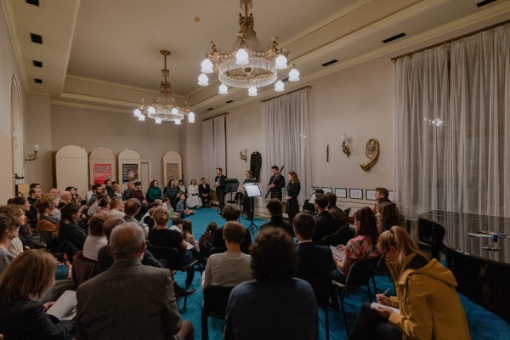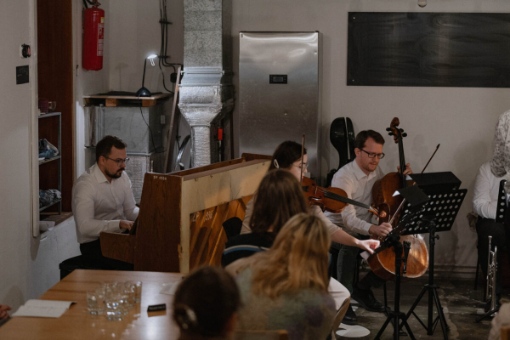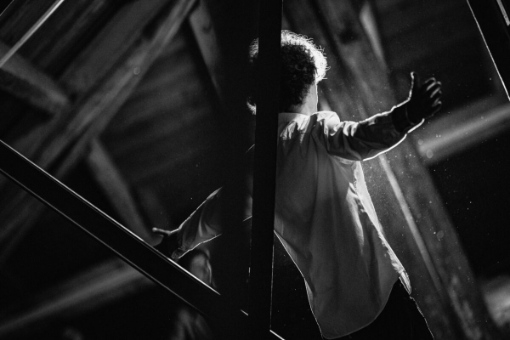The second New World of Moravian Autumn festival began on Thursday in Brno’s Besední dům. This project, by students of the Faculty of Music at the Janáček Academy of Performing Arts, was primarily originally created for the practical musical programming course and intended to be a one-off event during the Moravian Autumn the year before last. Subsequently, however, more students signed up and started working on a repeat festival. The dramaturgy for New World 2023 was handled by percussionists Adéla Spurná and David Paša, bassoonists Aneta Kubů and Josef Paik, and multimedia composer Martin Janda. Three concerts were prepared for 19, 20 and 21 October for this mini festival.
Thursday’s concert was divided into three parts, each taking place in a different space. The first was in the lounge by the foyer of Besední dům, where two ensembles composed of students at the JAMA wind instrument department performed. At the beginning, the composition Concert champêtre (Rural Concert) for oboe, clarinet and bassoon by French composer Henri Tomasi was performed by oboist Anna Kapsová, clarinettist Natálie Hrdová and bassoonist Josef Paik. This neoclassical work, divided into five miniatures, referred in its forms and harmonic progressions to Classicism, as well as to the Renaissance and the Middle Ages. The Concert champêtre posed several difficulties. The parts for the individual instruments were not easy and, for example, the bassoon was written quite high in some passages. Although there were a few inaccuracies in the interpretation and the musicians were not always completely coordinated, it was not a professional ensemble and they handled the piece well. Carl Nielsen’s Wind Quintet was the second piece. Anna Kapsová and Josef Paik were accompanied by flautist Kateřina Čechová, clarinettist Dominik Sedlák and horn player Kateřina Soukupová. As with the opening composition, this was a technically demanding work. All the musicians had a very pleasant tone, and even the more difficult runs were handled well. There were a few inaccuracies during the interpretation, but they did not spoil the composition’s overall impression.

For the second part, the audience moved to the adjacent Café Morgal, which is currently located in the courtyard of Pražák Palace, opposite the entrance to Besední dům, due to the renovation of the Moravian Gallery. Bohuslav Martinů’s La Revue de Cuisine was again performed by students at the JAMA Faculty of Music, this time accompanied by their teachers. A sextet composed of Dalibor Spilka – clarinet, Roman Novozámský - bassoon, Petr Čižinský – trumpet, Katarína Kožúriková – violin, Nikita Ruzhavinskii – cello and Dominik Gál – piano, was conducted by Vít Spilka. Café Morgal was a rather unusual space for the interpretation of this work. The acoustics were surprisingly good, and although the restaurant was a little busy and the atmosphere was more like sitting in a club with musical accompaniment, everything suited the La Revue de Cuisine. The musicians performed the piece in a completely professional manner, both technically and tonally. All in all, it was a very nice experience and one that brought a different perspective to the composition than from a classical performance in a concert hall.

The audience moved to the attic of Besední dům for the last part of the evening. Since the turnout was larger than the organisers had originally anticipated, the audience had to be divided into two halves, as not everyone could fit into the attic. The experimental composition Cageti by Martin Janda was performed. The piece’s name is a merging of the names Cage and Ligeti as it was inspired by their compositional approaches. The composer Martin Janda, who operated the electronics, was accompanied by bassoonist Aneta Kubů. The audience itself joined them at certain points as instructed by the performers, and thus became part of the composition. The audience provided three different sounds created with their mouths and one created with objects they had to hand (such as keys, jacket zips and mobile phones). The programme described and explained how they should respond to the instructions and was handed out before the performance. Cageti was divided into three parts. In the first, the audience joined in with the electronics and were fully drawn into the production right from the start. The second part belonged to the electronics and bassoon, and all the elements came together in the third. The concert offered an original concept that worked well and gave the audience an interesting experience.
































No comment added yet..